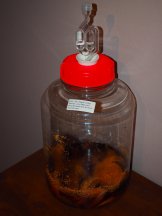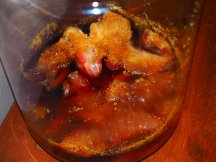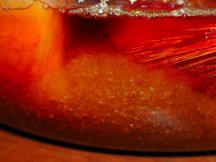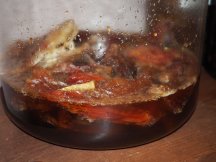How Is FAA Made?
1. Collect fish waste (head, bones, skin, fins, viscera) from deep sea, blue-back fish (mackerels, sardines, skipjack tuna, etc.).
2. Weigh the fish waste and mix it with an equal amount of brown sugar (1:1 ratio by weight).
3. Select a fermentation container (clay jar, plastic cooler) and place a layer of large rocks at the bottom to provide aeration, minor minerals, and an area where the liquids will collect during the fermentation process.
4. Place a layer of the fish by-product and brown sugar mixture on the rock layer and cover with more brown sugar. Continue with alternating layers of the fish by-product mixture and more brown sugar until the container is nearly full ending with a layer of brown sugar. Do not leave any fish exposed.
5. Add a handful of IMO#4 and a little Oriental Herbal Nutrients (OHN) to accelerate the fermentation process.
6. Cover the container with a breathable cloth to keep out insects but allow aeration, and store out of direct sunlight in a cool, well-ventilated location secured from animals.
7. After approximately 3 to 5 days, the fish waste will begin to break down and liquefy through fermentation and the osmotic pressure generated by the addition of brown sugar. However, the process takes 2 to 6 months to complete, producing mature FAA that is ready to use. FAA, when completely fermented, will have a sweet, slightly fishy odor.
8. Decant or pour off only the liquid portion from the fermentation container to use as FAA. The remaining solids can be used to make IMO#5 or placed in your compost pile
How Is FAA Used?
FAA is applied as a source of nitrogen during the early or vegetative stage of development to boost growth and size. Do not apply FAA if plants are at the reproductive stages of their production cycle when flowering or fruiting is desired. FAA is diluted with water (1:1,000)
Link to Info - Natural Farming: Fish Amino Acid | Welcome To Chuckers Paradise
Natural Farming: Fish Amino Acid
Eric Weinert, Jr., Sherri A. Miller, David M. Ikeda, Kim C. S. Chang, Joseph M. McGinn, and Michael W. DuPonte
Cho Global Natural Farming – Hawaii, Hilo, HI
College of Tropical Agriculture and Human Resources, Cooperative Extension Service, Hilo, HI



I used a 3 lbs of Tiliapia for this batch. I used the whole fish cut into 4 sections and in addition to OHN & IMO #5 I also add a dash of LAB. This is the first time I have tried using a brackish fish for FAA and don't know if the results will be as favorable as using a deep sea fish.
Pictures are 16 hours into the process
1. Collect fish waste (head, bones, skin, fins, viscera) from deep sea, blue-back fish (mackerels, sardines, skipjack tuna, etc.).
2. Weigh the fish waste and mix it with an equal amount of brown sugar (1:1 ratio by weight).
3. Select a fermentation container (clay jar, plastic cooler) and place a layer of large rocks at the bottom to provide aeration, minor minerals, and an area where the liquids will collect during the fermentation process.
4. Place a layer of the fish by-product and brown sugar mixture on the rock layer and cover with more brown sugar. Continue with alternating layers of the fish by-product mixture and more brown sugar until the container is nearly full ending with a layer of brown sugar. Do not leave any fish exposed.
5. Add a handful of IMO#4 and a little Oriental Herbal Nutrients (OHN) to accelerate the fermentation process.
6. Cover the container with a breathable cloth to keep out insects but allow aeration, and store out of direct sunlight in a cool, well-ventilated location secured from animals.
7. After approximately 3 to 5 days, the fish waste will begin to break down and liquefy through fermentation and the osmotic pressure generated by the addition of brown sugar. However, the process takes 2 to 6 months to complete, producing mature FAA that is ready to use. FAA, when completely fermented, will have a sweet, slightly fishy odor.
8. Decant or pour off only the liquid portion from the fermentation container to use as FAA. The remaining solids can be used to make IMO#5 or placed in your compost pile
How Is FAA Used?
FAA is applied as a source of nitrogen during the early or vegetative stage of development to boost growth and size. Do not apply FAA if plants are at the reproductive stages of their production cycle when flowering or fruiting is desired. FAA is diluted with water (1:1,000)
Link to Info - Natural Farming: Fish Amino Acid | Welcome To Chuckers Paradise
Natural Farming: Fish Amino Acid
Eric Weinert, Jr., Sherri A. Miller, David M. Ikeda, Kim C. S. Chang, Joseph M. McGinn, and Michael W. DuPonte
Cho Global Natural Farming – Hawaii, Hilo, HI
College of Tropical Agriculture and Human Resources, Cooperative Extension Service, Hilo, HI



I used a 3 lbs of Tiliapia for this batch. I used the whole fish cut into 4 sections and in addition to OHN & IMO #5 I also add a dash of LAB. This is the first time I have tried using a brackish fish for FAA and don't know if the results will be as favorable as using a deep sea fish.
Pictures are 16 hours into the process
Last edited:

